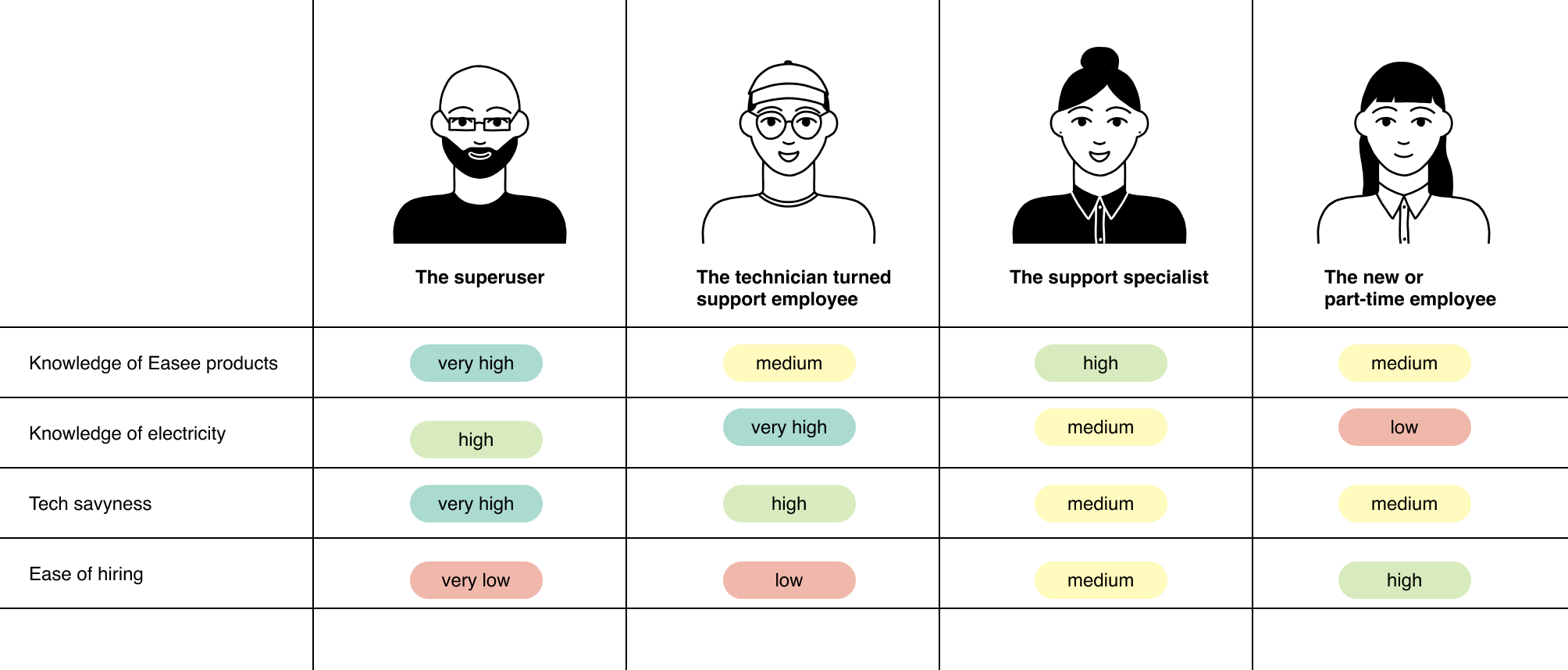Improving the support infrastructure
This project focused on improving the support and troubleshooting infrastructure for smart charging solutions from Easee.
Starting point
Comprehensive research and analysis on the support infrastructure of charging robots leading to the identification of opportunities for enhancing the experience and operational efficiency for Easee and its partners.
Design proposal
Discovery activities (interviews, contextual inquiry, UX analysis), strategy and ideation workshop, conceptualisation
Contribution to the project
This work was done during my time as design lead in the support tech squad at Easee in 2022-2023
Context
How can we design a support infrastructure that caters to the end-users' needs, rather than conforming to the internal organizational structure of the business?
Timeline
An unclear initial support flow
The experience of receiving support as an Easee charger owner can vary greatly depending on which service actor they contact. With multiple actors involved in the service and unclear roles and responsibilities, it can cause frustration for customers and make it challenging to hold partners accountable. Additionally, if partners lack the necessary tools, issues often go through lengthy escalation processes, placing a heavy burden on the customer excellence department at Easee. This lack of independence in troubleshooting for partners also makes it difficult for end-users to know when their issue will be resolved.
An unstructured support system
The absence of clear guidelines regarding which party the end-customer should contact has resulted in bottlenecks for both partners and the customer excellence department at Easee. By giving partners the right tools to conduct support and troubleshooting activities and by establishing explicit roles and responsibilities, end-users could receive support more quickly, and the escalation process can be made more dependable.
A shift in focus
To create a more reliable and efficient support system, we redirected our attention from our internal support operations to addressing the needs and challenges of our partners. By doing so, we aimed to enhance their operational processes, while also generating consistent revenue streams for Easee.
Strategy activities
In addition to conducting discovery activities, I facilitated various strategy workshops with my team, including lean canvas activities, assumption workshops, OKR workshops, and team canvas workshops. The goal was to ensure that we were all on the same page regarding our objectives and to determine what type of business model would best support our solution. These workshops not only provided clarity on our work but also improved everyone's understanding of other team members’ ideas, assumptions, and motivations.
Identifying the pain points of the people working in support
In an effort to gain a deeper understanding of the partners' operations, I conducted contextual inquiry activities, interviews, and workshops with their support personnel. This approach enabled me to obtain valuable insights into their daily routines and build stronger relationships with them. Additionally, by training my teammates on conducting contextual inquiry activities, we were able to broaden our scope of insights and gain a more comprehensive understanding of our partners' needs.
Findings
After conducting our discovery activities, I compiled a document containing all the insights we gathered. This facilitated a better understanding of the present situation among the team and management, as well as enabled everyone to be adequately prepared for the ideation workshop aimed at defining the future vision for our support and troubleshooting tool.
New personas to design for
In order to grant partners access to Easee's internal tool for support and troubleshooting, it was important to gain a thorough understanding of their support teams.
Recruiting individuals with technical proficiency was one of the primary obstacles faced by the partner companies, often leading to substantial resources being expended on training new hires for support and troubleshooting tasks.
Improving the troubleshooting journey
By conducting discovery activities with the support personnel of partner companies, and Easee's internal customer excellence team, I gained a better comprehension of the emotional experience involved in providing support. Two main observations were made. Firstly, end-customers often lack knowledge of EV charging, leading to many calls being more focused on educating the customer rather than resolving the issue. And when there is a problem, communicating the issue to the support agent can be challenging, as the customers may struggle to express themselves accurately. The second main observation was that the support tool is difficult to comprehend, causing many support agents having to escalate the issue further while feeling frustrated or insecure.
Ideation workshop: A future vision
The research conducted enabled us to uncover several potential areas for development. I presented these ideas as low-fidelity sacrificial prototypes, which were then reviewed, enhanced, or discarded in a final workshop with the support tech squad and the product director.
This approach provided the team with a clearer sense of the path forward, and the open discussion allowed all members to better grasp the potential impact and viability of each concept in terms of feasibility, usability, and desirability.
You can see these early concepts in the slideshow below.
Conclusion and personal reflections
After the future vision workshop where the team members agreed on the tool's future direction, my work with the support squad ended. It was fulfilling to witness the team's enthusiasm about the upcoming work, and it marked a gratifying end to my contribution to the team.
My time at Easee's support tech squad was a valuable learning experience. It broadened my perspective of a designer's role beyond interface enhancement to system optimization. Moreover, it highlighted the significance of creating opportunities to ensure team alignment. When dealing with a pre-existing product, there is a constant stream of tasks, requests, and obstacles that can derail the team's focus from the overall strategy. However, by regrouping and assessing the best use of resources, the team not only benefits the product's development but also fosters team cohesion and enables everyone to be heard.

























